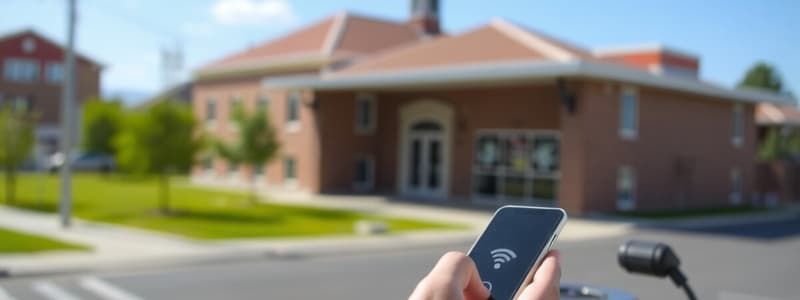Podcast
Questions and Answers
Wireless technology uses what to send and receive data?
Wireless technology uses what to send and receive data?
- Fiber optic cables
- Ethernet cables
- Licensed radio spectrum
- Unlicensed radio spectrum (correct)
Access to the unlicensed radio spectrum requires what?
Access to the unlicensed radio spectrum requires what?
- Subscription to cable internet
- Special license from the government
- Fiber optic cables
- Wireless router (correct)
What is a typical range limitation of wireless access?
What is a typical range limitation of wireless access?
- 500 feet
- Less than 100 feet (correct)
- 10 miles
- 0.5 miles
What is a major characteristic of Municipal Wi-Fi networks?
What is a major characteristic of Municipal Wi-Fi networks?
What does a subscriber typically need to connect to a municipal Wi-Fi network?
What does a subscriber typically need to connect to a municipal Wi-Fi network?
What is cellular service used for?
What is cellular service used for?
What is the primary function of devices using cellular technology?
What is the primary function of devices using cellular technology?
What does '3G/4G/5G' refer to?
What does '3G/4G/5G' refer to?
What upload bandwidth does 4G typically support?
What upload bandwidth does 4G typically support?
What is the expected maximum download bandwidth of 5G?
What is the expected maximum download bandwidth of 5G?
What does LTE stand for?
What does LTE stand for?
Where is Satellite Internet typically used?
Where is Satellite Internet typically used?
What equipment is needed for satellite internet access?
What equipment is needed for satellite internet access?
What is an important installation consideration for satellite internet?
What is an important installation consideration for satellite internet?
Which IEEE standard describes WiMAX?
Which IEEE standard describes WiMAX?
Which technology has largely replaced WiMAX for mobile access?
Which technology has largely replaced WiMAX for mobile access?
What risk is associated when a teleworker uses a broadband service to access a corporate WAN over the internet?
What risk is associated when a teleworker uses a broadband service to access a corporate WAN over the internet?
What is the purpose of VPN connections?
What is the purpose of VPN connections?
What are VPN tunnels?
What are VPN tunnels?
Which is a benefit of using VPNs?
Which is a benefit of using VPNs?
What level of security do VPNs provide?
What level of security do VPNs provide?
What makes VPNs scalable?
What makes VPNs scalable?
What type of broadband do VPNs work with?
What type of broadband do VPNs work with?
What type of VPN has settings configured on routers?
What type of VPN has settings configured on routers?
Which VPN type requires the user to initiate the connection?
Which VPN type requires the user to initiate the connection?
What is a key characteristic of a single-homed ISP connectivity?
What is a key characteristic of a single-homed ISP connectivity?
What does dual-homed ISP connectivity provide?
What does dual-homed ISP connectivity provide?
What defines Multihomed ISP connectivity?
What defines Multihomed ISP connectivity?
Which ISP connectivity provides the most redundancy?
Which ISP connectivity provides the most redundancy?
Which is an ideal broadband solution?
Which is an ideal broadband solution?
What is a drawback to cable broadband?
What is a drawback to cable broadband?
Why is DSL bandwidth limited?
Why is DSL bandwidth limited?
What is require for the installation of Fiber-to-the-Home?
What is require for the installation of Fiber-to-the-Home?
What's a common limitation of cellular/mobile broadband?
What's a common limitation of cellular/mobile broadband?
What is a downside of satellite internet?
What is a downside of satellite internet?
What is the primary purpose of a VPN?
What is the primary purpose of a VPN?
What is used to keep data confidential in a VPN?
What is used to keep data confidential in a VPN?
Cisco AnyConnect is what?
Cisco AnyConnect is what?
Modern VPNs now support:
Modern VPNs now support:
Site-to-Site VPNs is created when
Site-to-Site VPNs is created when
Remote-Access VPN is
Remote-Access VPN is
What is an advantage of Dual-homed ISP connectivity?
What is an advantage of Dual-homed ISP connectivity?
What is a characteristic of Multihomed ISP connectivity?
What is a characteristic of Multihomed ISP connectivity?
What is the most resilient ISP connectivity topology?
What is the most resilient ISP connectivity topology?
What broadband solution generally has limited coverage, especially within buildings?
What broadband solution generally has limited coverage, especially within buildings?
Flashcards
Wireless Technology
Wireless Technology
Wireless technology uses the unlicensed radio spectrum to transmit and receive data.
Municipal Wi-Fi
Municipal Wi-Fi
Wireless networks set up by cities, offering free or low-cost high-speed internet access.
Cellular
Cellular
Technology using cellular service to connect devices to the internet.
3G/4G/5G Wireless
3G/4G/5G Wireless
Signup and view all the flashcards
Long-Term Evolution (LTE)
Long-Term Evolution (LTE)
Signup and view all the flashcards
Satellite Internet
Satellite Internet
Signup and view all the flashcards
WiMAX
WiMAX
Signup and view all the flashcards
VPN
VPN
Signup and view all the flashcards
Site-to-site VPN
Site-to-site VPN
Signup and view all the flashcards
Remote Access VPN
Remote Access VPN
Signup and view all the flashcards
Single-homed ISP
Single-homed ISP
Signup and view all the flashcards
Dual-homed ISP
Dual-homed ISP
Signup and view all the flashcards
Multihomed ISP
Multihomed ISP
Signup and view all the flashcards
Dual-multihomed ISP
Dual-multihomed ISP
Signup and view all the flashcards
Broadband Solution
Broadband Solution
Signup and view all the flashcards
Fiber-to-the-Home
Fiber-to-the-Home
Signup and view all the flashcards
Virtual Private Network
Virtual Private Network
Signup and view all the flashcards
Cisco AnyConnect
Cisco AnyConnect
Signup and view all the flashcards
VPN Benefits
VPN Benefits
Signup and view all the flashcards
VPN: Cost Savings
VPN: Cost Savings
Signup and view all the flashcards
VPN: Security
VPN: Security
Signup and view all the flashcards
VPN: Scalability
VPN: Scalability
Signup and view all the flashcards
VPN: Compatibility
VPN: Compatibility
Signup and view all the flashcards
Site-to-Site VPN
Site-to-Site VPN
Signup and view all the flashcards
Remote-Access VPN
Remote-Access VPN
Signup and view all the flashcards
Clientless VPN Connection
Clientless VPN Connection
Signup and view all the flashcards
Client-based VPN Connection
Client-based VPN Connection
Signup and view all the flashcards
Site-to-Site IPsec VPNs
Site-to-Site IPsec VPNs
Signup and view all the flashcards
GRE over IPsec
GRE over IPsec
Signup and view all the flashcards
Passenger protocol
Passenger protocol
Signup and view all the flashcards
Carrier protocol
Carrier protocol
Signup and view all the flashcards
Transport protocol
Transport protocol
Signup and view all the flashcards
Study Notes
Wireless Internet-Based Broadband
- Wireless tech utilizes the unlicensed radio spectrum for sending and receiving data
- Anyone with a wireless router and compatible technology can use the unlicensed spectrum
- Earlier wireless access was limited by the local transmission range, typically within 100 feet of a wireless router with a wired internet connection
Municipal Wi-Fi
- Many cities are establishing municipal wireless networks
- Some municipal networks offer high-speed internet access for free or at a reduced cost
- Some are intended for city use, enabling remote work for police, fire departments, and other city employees
- To connect, subscribers need a wireless modem with a stronger radio and directional antenna
- Service providers often offer the equipment for free or for a fee, similar to DSL or cable modems
Cellular Service
- Another wireless WAN tech option used to connect users and remote locations lacking alternative WAN access tech
- Smartphones and tablets can use cellular data for email, web browsing, app downloads, and video streaming
- Phones, tablets, laptops, and even routers communicate to the internet using cellular tech
- Devices use radio waves to communicate through nearby mobile phone towers
- Devices have small radio antennas while providers have larger antennas
Wireless Standards
- 3G/4G/5G are abbreviations for mobile wireless technologies generations
- 3G, 4G, and 5G support wireless internet access
- 4G standards bandwidths can reach up to 450 Mbps download and 100 Mbps upload speeds
- 5G standards can support 100 Mbps to 10 Gbps and beyond
Long-Term Evolution (LTE)
- A newer, faster tech and part of the fourth generation (4G) tech
Satellite Internet
- Typically used by rural or remote users where cable and DSL options are unavailable
- Access requires a satellite dish, two modems (uplink and downlink), and coaxial cables between the dish and modem
- Signals travel about 35,786 kilometers (22,236 miles) to the satellite and back
- A clear view toward the equator is a installation requirement, where satellites orbit
- Trees and heavy rains can impact signal reception
- Satellite internet provides two-way data communications, with download speeds ranging from 5 Mbps to 25 Mbps and upload speeds being about one-tenth of the download speed
WiMAX
- Worldwide Interoperability for Microwave Access (WiMAX) is a new tech
- Described in IEEE standard 802.16
- It provides high-speed broadband service with wireless access and broad coverage
- Offers broader coverage similar to cell phone networks, unlike small Wi-Fi hotspots
- Works similarly to Wi-Fi but at higher speeds, over greater distances, and for more users, using WiMAX towers
- Access requires a subscription to an ISP with a WiMAX tower within 30 miles, a WiMAX receiver, and an encryption code
- WiMAX has been largely replaced by LTE for mobile access and cable or DSL for fixed access
VPN Technology
- Security risks arise when teleworkers or remote office workers use broadband to access the corporate WAN over the internet
- Broadband services offer Virtual Private Networks (VPN) to address these security concerns
- The network device accepting VPN connections is typically at the corporate site
Virtual Private Networks (VPNs)
- VPN is an encrypted connection between private networks over a public network like the internet
- Instead of leased lines, VPNs use virtual connections called VPN tunnels
- VPN tunnels route through the internet from the private network to the remote site or employee host
Benefits of Using VPN
- Cost savings: organizations can use the global internet to connect remote sites and users, eliminating WAN links
- Security: enhanced with encryption and authentication protocols that protect data from unauthorized access
- Scalability: VPNs use existing internet, making it easier to add new corporate users without significant infrastructure changes
- Compatibility: VPN tech works with broadband like DSL and cable, allowing remote workers to access corporate networks via high-speed internet
Common VPN Implementations
- Site-to-site VPN: VPN settings are configured on routers, so clients are unaware of data encryption
- Remote access: initiates remote access connection. For example, using HTTPS or VPN client software with authentication
ISP Connectivity options
- Single-homed: Used if internet access is not crucial, client connects to ISP using one link - It offers no redundancy and is the least expensive option
- Dual-homed: Used if internet access is crucial, client connects to same ISP using two links - Its offers redundancy and load balancing, but the organization loses connectivity if the ISP experiences an outage
- Multihomed: Client connects to two different ISPs - It offer redundancy and load balancing, but it can be expensive
- Dual-multihomed: The client connects with redundant links to multiple ISPs - It is the most resilient and expensive option
Broadband Solution Comparison Factors
- Fiber-to-the-Home: Requires direct fiber installation
- Cable: Bandwidth is shared, resulting in slow upstream data rates with over-subscription
- DSL: Bandwidth is distance-sensitive with a lower upload rate
- Cellular/Mobile: Coverage and limited bandwidth are often an issue
- Municipal Wi-Fi: Viable if mesh network is available and in range
- Satellite: Expensive, limited capacity, used when no other option available
Virtual Private Network
- Organizations use VPNs to secure traffic between sites and users, creating end-to-end private network connections
- A VPN is virtual carrying information within a private network but transported over a public network
- Encryption to keep the data confidential
Cisco Security and VPNs
- A Cisco Adaptive Security Appliance (ASA) firewall can provide secure, high-performance connectivity, including VPNs, for remote branches and mobile users
- SOHO (small office home office) can utilize a VPN-enabled router for VPN connectivity back to corporate
General VPN Benefits
- Increased ability for an established client-based VPN connection with the main site, using AnyConnect
- Modern VPNs provide encryption features for secure network traffic between sites (IPsec,SSL)
- Cost-effective, broadband enable cost-effective remote connection bandwidth, lowering connectivity costs
- The most security available, with encryption and authentication to protect data from unauthorized access
- Scalability is easy because VPN allows internet usage, without costly infrastructure
- Compatibility VPNs work with WAN links and broadband: Remote workers using Broadband advantage
Studying That Suits You
Use AI to generate personalized quizzes and flashcards to suit your learning preferences.




